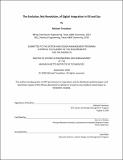| dc.contributor.advisor | Donna H. Rhodes. | |
| dc.contributor.author | Trevathan, Michael
(Michael Thomas) | en_US |
| dc.contributor.other | Massachusetts Institute of Technology. Engineering and Management Program. | en_US |
| dc.contributor.other | System Design and Management Program. | en_US |
| dc.date.accessioned | 2021-10-08T16:58:54Z | |
| dc.date.available | 2021-10-08T16:58:54Z | |
| dc.date.copyright | 2020 | en_US |
| dc.date.issued | 2020 | en_US |
| dc.identifier.uri | https://hdl.handle.net/1721.1/132834 | |
| dc.description | Thesis: S.M. in Engineering and Management, Massachusetts Institute of Technology, System Design and Management Program, September, 2020 | en_US |
| dc.description | Cataloged from the official version of thesis. | en_US |
| dc.description | Includes bibliographical references (pages 150-159). | en_US |
| dc.description.abstract | High impact digital innovations present opportunities for organizations to transform their business capabilities to adapt for future sustainability. To adopt new platforms offered by disruptive technologies, organizations must alter or retire existing business models, create and develop new competencies, and build an agile business culture. An organization's failure to respond to evolving digital initiatives will inevitably lead to a loss of competitive advantage and even obsoletion. Undertaking and managing transformative digital solutions may seem risky, but the alternative is riskier. This thesis explores the opportunities associated with integrating digital technologies into established oil and gas (O&G) organizations where transformation will be exceedingly difficult. Investing in the right technologies that fit the organizational size, competencies, and culture is critical for the success of adopted digital initiatives. Case studies reviewing digital investment portfolios within the O&G industry are presented to evaluate the investment size, capabilities, and realized value creation associated with digital integration on design and operations. A systems approach was employed to understand the barriers and limitations to digital integration in the following areas: data value chain and workflows, data architecture standardization, and end-to-end lifecycle integration, with emphasis on O&G drilling and completion operations. Additionally, a business strategy roadmap was created to recommend realized value opportunities for a digital investment portfolio to succeed in this constantly evolving marketplace. | en_US |
| dc.description.statementofresponsibility | by Michael Trevathan. | en_US |
| dc.format.extent | 159 pages | en_US |
| dc.language.iso | eng | en_US |
| dc.publisher | Massachusetts Institute of Technology | en_US |
| dc.rights | MIT theses may be protected by copyright. Please reuse MIT thesis content according to the MIT Libraries Permissions Policy, which is available through the URL provided. | en_US |
| dc.rights.uri | http://dspace.mit.edu/handle/1721.1/7582 | en_US |
| dc.subject | Engineering and Management Program. | en_US |
| dc.subject | System Design and Management Program. | en_US |
| dc.title | The evolution, not revolution, of digital integration in oil and gas | en_US |
| dc.type | Thesis | en_US |
| dc.description.degree | S.M. in Engineering and Management | en_US |
| dc.contributor.department | Massachusetts Institute of Technology. Engineering and Management Program | en_US |
| dc.identifier.oclc | 1263351078 | en_US |
| dc.description.collection | S.M.inEngineeringandManagement Massachusetts Institute of Technology, System Design and Management Program | en_US |
| dspace.imported | 2021-10-08T16:58:54Z | en_US |
| mit.thesis.degree | Master | en_US |
| mit.thesis.department | SysDes | en_US |
